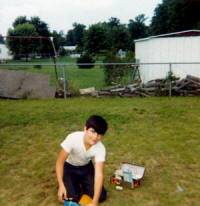
Yours Truly (Kirt Blattenberger) with
Cox PT-19 Trainer in back yard at 114 River
Road, Edgewater, Maryland. My Estes rocket range box did double duty as a model
airplane field box. Note that it is what is nowadays an impossible to find metal
Range Box, Cat. No. 651-RB-1
Read the complete
Christmas Eve 1969 edition of the
Evening Capital newspaper. We had a rare white Christmas that year!
114 River Road, Edgewater,
MD 21037 (originally Rt. 4 box 504) is where I grew up - or more appropriately,
got older - and spent as much time as possible building and flying every kind of
airplane, rocket, and helicopter I could get my hands on. It has been close to 20
years since going back there (both parents died many moons ago), but thanks to the
miracle of Google Earth, I was able to grab this satellite image of the old stomping
grounds (see
Google Map view).
It looks pretty much the way I remember it. My father and I built the addition
on the southwest end, and the porch on the southeast side. That section of sidewalk
that goes nowhere now used to terminate at a 10'x10' steel shed. Those two outbuildings
in the back yard are new. In the zoomed out view of the Google map (below) you can
see the entire neighborhood of Holly Hill Harbor. Explanations of the markings will
be given later in the story.
The yellow circle is approximately where I flew and eventually crashed many control
line airplanes. After destroying the first couple Cox plastic models I received
as presents at Christmas and/or birthdays, I finally got wise and bought a
Cox PT-19 Trainer. It was with
the PT-19 Trainer that I finally learned to fly a control line airplane. Previous
attempts were similar to what many (dare I say most?) people new to control line
do, where after finally getting the engine to start and stay running, I would feed
in up elevator to make the model struggle into the air long before it should have,
and then as it stalled or began to climb and dive, I would feed in full up elevator
until it eventually crashed. Back in those days, there was no kind of adhesive that
would successfully hold the molded styrene plastic back together sturdily enough
to let the darn thing fly again, so into the trash they would go. I do recall one
time trying to weld the cracked fuselage on a Corsair back together using a soldering
iron, but all that did was get me yelled at by my mother for stinking up the house.
Come to think of it, I got yelled at a lot for the things I tried.
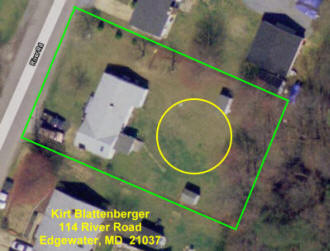
My childhood house in Holly Hill Harbor
Eventually, my good flying buddy, Jerry Flynn, and I were building balsa models
with Silkspan covering. Neither of us had much money, so we learned to stretch a
buck pretty good. We flew many a C/L combat contest in that back yard using Carl
Goldberg kits with Cox Baby Bee .049 engines. We usually didn't have anyone to launch
for us, so one of us would first launch the other, and then frantically try to start
the other plane and self-launch by holding the lines way up near the airplane and
slowly feeding them out between our fingers. It was quite a trick, and probably
would be deemed very unacceptable by today's safety standards.
Fortunately, the good times outnumbered the bad times with all my models, so
my interest has lasted a lifetime (51 years as I write this).
Also in that very same back yard were launched many an Estes rocket. As you can
see, the tree line along the back, combined with a lot of other trees and house
roofs, made for a somewhat hostile environment for launching model rockets. I would
typically use no more than a "B" size engine. After a while, I got pretty good at
adjusting the launch pad angle to compensate for wind. Most of my parachutes had
holes cut in the tops to help bring the rockets down as quickly as possible without
damaging them. I managed to get most of the rockets back, but occasionally one would
stray into the woods. Bing a stupid kid, I would gladly risk life and limb to recover
a rocket from the highest of trees. If my mother knew some of the trees I climbed,
she'd have had a fit. On its maiden flight, my Gyroc, twisted itself down into the top of a tree that was easily
80 feet high. It took a couple attempts of after-school searching (no binoculars,
but 20/15 vision then) to even find it, and then a couple attempts to retrieve it.
It was pretty scary being up that high.
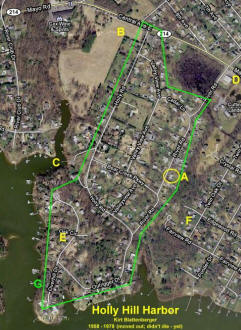
My paper route domain in Holly Hill Harbor
If you take a look at the Holly Hill Harbor map, you will see an area labeled
"B." That is a big field that - hard to believe - is still a big field. A very generous
family by the name of Klinken owned it, and graciously allowed just about anyone
who did not abuse it to use it. At one time there was a baseball diamond set up
for the area little league games, but judging from the photo it does not appear
to exist anymore. It was referred to as "Klinken's Field." Jerry and I used to launch
our rockets there, which greatly improved our chances of recovering rockets. At
least that is what you might expect, except that the bigger area gave us more courage
to use even bigger rocket engines. Estes "C" engines became the preferred series,
and man, did those suckers fly!!! No longer were our rocket chases confined to within
a couple hundred feet of the launch site - now we regularly chased them across entire
neighborhoods! Dumb kids.
When we graduated to larger control line models, like Sterling's Ringmaster and
Sig's Akrobat, using Fox .35s and 70-foot
steel lines, my back yard no longer sufficed, so we moved that activity to Klinken's
Field as well. As with the rockets, it provided a greater opportunity for greater
losses. We did not hesitate to take advantage of the opportunity. Did I mention
that neither Jerry nor I had much money? Well, because of that inconvenient fact,
we did not have an electric starter for the engines. Anyone who has owned a
Fox .35 engine knows what a challenge
it is getting them running in the right direction by hand-flipping the propeller.
We did not have very good batteries, either, so that just added to the challenge.
Odd as it may seem, there was actually great joy in kneeling by the model, endlessly
flipping the prop and waiting for that sudden sound of the engine springing to life.
One more bit of nostalgia about those Fox .35s before I move on... they would commonly
backfire after becoming flooded, and would catch on fire. That necessitated picking
up the airplane and frantically swinging it around in the air trying to put the
fire out. Good thing Mom didn't know about that, either, or she might have insisted
that I take up team sports instead of model airplanes and rockets ;-)
If you have bothered to read this far, then maybe you are also interested in
the key points flagged on the Holly Hill Harbor map. Point "A" is my boyhood house
(well, my parent's house, technically). Point "B" is Klinken's Field. Point "C"
is the neighborhood pier, where many a fun time was had. Jerry Flynn and I also
got radio controlled boats at the same time (we were around 16 by then), and we
ran them there often. Those engines we equally troublesome to get started. Again,
with no electric starter we had to resort to looping a piece of string around the
grooved flywheel and hand crank them. I had a Pride of Pay N Pak and Jerry had a Miss Budweiser (unlimited hydroplanes
by Dumas). When the engine quit and the boat was too far away to toss the ball tied
to the fishing line over to retrieve, guess how we got them back? Yup, time for
a swim. One time around March my hydroplane quit, so into the frigid water I went.
Guess who was not pleased when I came in the door at home soaking wet? But I digress.
Point "D" is the little shopping plaza where I had my first real job other than
a paper route. I worked for a sporting goods/hobby shop part-time stocking shelves
and sweeping floors. Unfortunately, the store did not last long. Point "E" is (was)
a large section of wooded area where all the guys in the neighborhood (and some
of the girls) would play war, ride our bikes, fight, build little fires to melt
the plastic 6-pack can holders and listen to the cool ffft, ffft, ffft sound as
the plastic dripped into the fire. It was a very hilly area as well, and we cleared
long, winding paths to facilitate high-speed races on our bikes. We'd get banged
up from time to time, but it came with the territory. Oh, and there was no such
thing as a bicycle helmet in those days. On the NW side of the area were cliffs
about 20-30 feet high. They seemed many times higher to us. There was a huge tree
with a huge branch that extended out over the water, and some kind soul had tide
a thick rope to it as a swing. Thick rope was plentiful in that area because of
all the boats that used it. The most daring of kids (I probably was not one of them)
would stand up on the top of the cliffs and jump off with the rope to swing way
out over Bear Creek and usually ended up doing a belly flop or some other ungraceful
maneuver into the water. I preferred to execute my belly flops from lower altitudes.
By the way, Holly Hill Harbor is so-named because of abundance of holly plants
that grew there naturally. We always had holly for Yule logs and wreaths at Christmastime.
Point "F" is where Jerry Flynn lived with his grandparents in Ponder Cove. I
don't know how much pondering was done in that cove, but it's a cool name. Going
"outside the neighborhood" was considered a great privilege and sign of maturity
whilst in your early teens in the 1960s & 1970s, and even though we were separated
by less than a hundred feet of woods, there was something cool about having a friend
in Ponder Cove.
Point "G" is where a horse-sized Weimaraner dog named, appropriately, Schultz,
lived. His sole purpose in life was to wait for me to arrive on my bicycle each
afternoon with a newspaper bag slung over my shoulder. He stood at the end of the
cul-de-sac and dared me to advance. We're talking almost every day. There were times
I had to jump off my bike and keep it between Schultz and me until he got tired
of playing with the human and went away. When I would call the owners (who were
not customers, by the way), they constantly assured me that good old Schultz wouldn't
harm a fly. Too bad for me I wasn't a fly, or I would have had it made. My father,
who worked as the classified ad department manager at the newspaper (The Evening
Capital, now just The Capital) asked at work of people in the circulation room
how other carriers handled such a dilemma. Their method worked like a charm - hairspray.
Employing such a technique today would land you in jail, but back then most people
considered the safety of human beings more important than the well-being of a dog.
Yeah, it only took a couple times of Alberto VO5 hair spray in the face to convince
Schultz to find a new form of afternoon entertainment. From then on, I always packed
a can of spray in my paper bag.
Speaking of paper routes, the green outline represents the region that I served
on my route. Boy, could I fill the page with stories of the paper route saga - from
other canine encounters to encounters with humans not much better than the dogs.
That concludes this chapter of the life and times of Kirt Blattenberger. I kept
waiting for someone else to write the story, but nobody has, so it's up to me. I'm
glad to do it.
If there are any of my friends from the old "Hood" out there who see this story
and care to chime in, please do so either below in the comments area, or send me
an
e-mail. It'll be good the hear from you.
October 2016: The Enchanted Forest
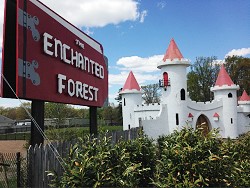 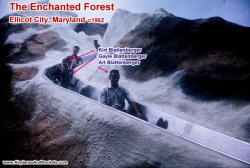 My sister, Gayle, sent me some old slides
a year or so ago that had images from a trip to
The Enchanted
Forest, in Elliot City, Maryland, back in the 1960s. I did an Internet search
looking for info on Enchanted Forest and did not find much. I just repeated the
search and came across this major source of photos of the work performed by
Clark's Elioak
Farm. WTOP ran a feature titled "Maryland
Woman Works to Preserve Enchanted Forest Memories," that describes a bit of
the place's history. It opened in 1955 and closed in the 1980s. The photos on
The Enchanted
Forest website show both old and new exhibits. I hope to soon post a few more
photos from the Enchanted Forest in the 1964 timeframe. My sister, Gayle, sent me some old slides
a year or so ago that had images from a trip to
The Enchanted
Forest, in Elliot City, Maryland, back in the 1960s. I did an Internet search
looking for info on Enchanted Forest and did not find much. I just repeated the
search and came across this major source of photos of the work performed by
Clark's Elioak
Farm. WTOP ran a feature titled "Maryland
Woman Works to Preserve Enchanted Forest Memories," that describes a bit of
the place's history. It opened in 1955 and closed in the 1980s. The photos on
The Enchanted
Forest website show both old and new exhibits. I hope to soon post a few more
photos from the Enchanted Forest in the 1964 timeframe.
 Are you old enough
to remember the
mosquito spray trucks running through your neighborhood during the summer? Whilst
a child living in
Mayo, Maryland, in the 1960s, I vividly remember trucks similar to this one
going by our house with a big fan on the back blowing what was almost certainly
DDT with such force that it shook
the trees. We would hurry to shut all the windows if lucky enough to hear the truck
coming. That stuff stunk. Mayo is a peninsula off the Chesapeake Bay, and it was
a breeding ground for skeeters. If you went outside in the evening after a rain
on a hot, humid day, you would get eaten alive - so to speak. A can of "Off Insect
Repellant" sat on our back door stoop all summer long. Remember the
"Off" commercial? Mosquitoes
don't bite; they don't even light." Boy, am I getting old! According to the hype,
all of my friends and I should be dead by now. Are you old enough
to remember the
mosquito spray trucks running through your neighborhood during the summer? Whilst
a child living in
Mayo, Maryland, in the 1960s, I vividly remember trucks similar to this one
going by our house with a big fan on the back blowing what was almost certainly
DDT with such force that it shook
the trees. We would hurry to shut all the windows if lucky enough to hear the truck
coming. That stuff stunk. Mayo is a peninsula off the Chesapeake Bay, and it was
a breeding ground for skeeters. If you went outside in the evening after a rain
on a hot, humid day, you would get eaten alive - so to speak. A can of "Off Insect
Repellant" sat on our back door stoop all summer long. Remember the
"Off" commercial? Mosquitoes
don't bite; they don't even light." Boy, am I getting old! According to the hype,
all of my friends and I should be dead by now.
Posted August 8, 2023
(updated from original post on 8/18/2007)
|



